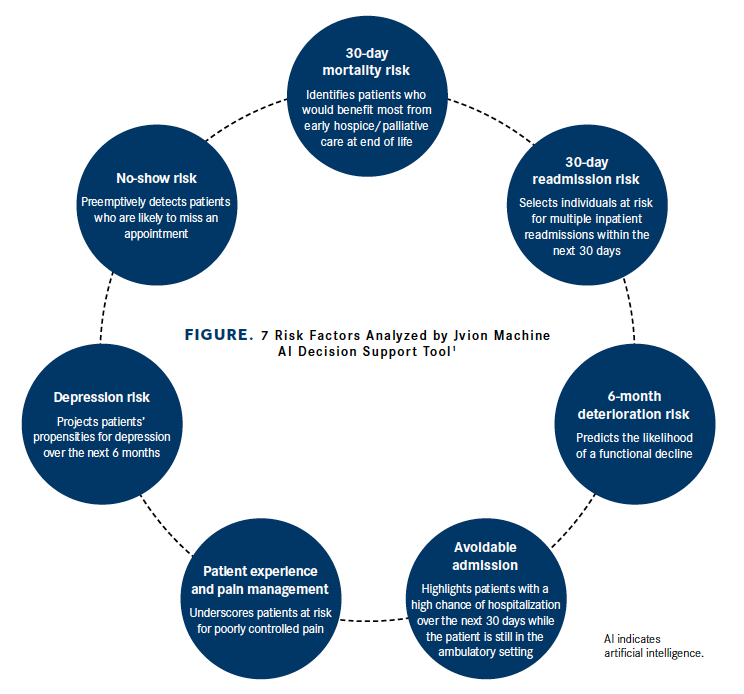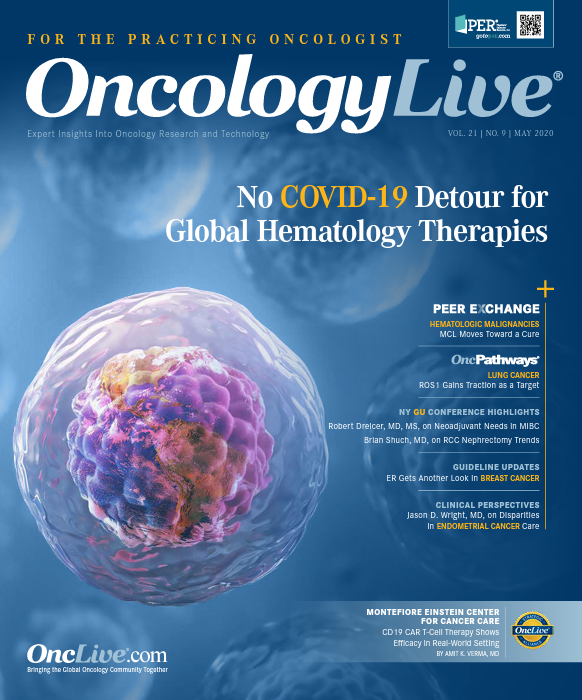Publication
Article
AI System Helps Guide Care for High-Risk Patients in Oncology
Author(s):
In an era of value-based care, the ability to triage the needs of patients with cancer who are most likely to experience significant difficulties is becoming a priority for community oncology practices and hospital systems.
Barry Russo

Barry Russo
In an era of value-based care, the ability to triage the needs of patients with cancer who are most likely to experience significant difficulties is becoming a priority for community oncology practices and hospital systems.
Jvion, a developer of analytics software, and Cardinal Health Specialty Solutions, a health care services and products company, have teamed up to create an artificial intelligence (AI) decision support tool that helps oncology specialists identify high-risk patients and manage their care.
The Jvion approach has broad application across specialties, including utility for health care providers treating patients affected by the coronavirus disease 2019 (COVID-19). Through an analysis of claims and other available data of nearly 4 million patients, the company created a COVID-19 Patient Vulnerability List that identified approximately 200,000 at risk for the most severe outcomes caused by the pandemic.1
In oncology, the Jvion Machine demonstrated its ability to generate actionable insights on high-risk patients during an initial pilot at 3 practices in the United States: The Center for Cancer and Blood Disorders in Fort Worth, Texas; Northwest Medical Specialties (NWMS) in Tacoma, Washington; and Tennessee Oncology in Nashville, Tennessee.
“Through the pilot process, we found that the Jvion Machine was identifying the highrisk patients who would require major case management or focus,” said Barry Russo, chief executive officer of The Center for Cancer and Blood Disorders. “Now, my case management staff works from the Jvion-generated list of patients. That’s who they’re reaching out to, to try to manage and improve the coordination of care while reducing the costs that these patients are incurring.”
The risk stratification data that the Jvion Machine provides enables Russo’s clinic to select the at-risk subset of its patient population and preemptively address avoidable events, such as unnecessary hospital admissions. The oncology clinic typically facilitates care for 1200 to 1500 patients, a number that is far too large to call patients individually to assess potential risk, Russo said. “It’s helped us home down to less than 200 patients who our case management team can hyper focus on,” Russo said.
The Jvion Machine uses clinical and nonclinical factors, such as patient socioeconomic status and environment, to analyze a patient’s risk for 7 vectors: 30-day mortality risk, 30-day readmission risk, 6-month deterioration risk, avoidable admission, patient experience and pain management, depression risk, and no-show risk (Figure).2 When the Jvion Machine identifies a patient on a trajectory toward a target event such as hospitalization, the decision support tool recommends individualized interventions that can improve patient outcomes.3
This feature has contributed to the “great success” the NWMS has realized in the past 2 years that the Jvion Machine has been in use across the 6-site oncology practice, according to Amy Ellis, director of Quality and Value Based Care at Northwest Medical Specialties, PLLC.
“When we started using the Jvion Machine, we saw a significant uptick in our hospice referrals and hospice utilization,” Ellis said. “I think this [tool] is changing our providers’ mindsets and prompting them to more quickly refer their patients to hospice.”
Data from NWMS, which attends to more than 1700 oncology cases each year, showed an 81% increase in the number of patients referred to palliative and hospice care following the implementation of the Jvion Machine. This was accompanied by an 80% rise in case management evaluations and broader screening (68%) of patients for depression.3
Timely hospice referrals have historically been challenging for NWMS. “Practices across the country struggle with the end-of-life [care] and referring patients to hospice in a timely manner, and so has our practice. We’ve really struggled with getting those hospice referrals. We’ve done a lot of work to streamline our relationships with the hospitals and providers in the area and to better our workflows to make the process more efficient so that once we know which patients needed to be referred, we can get them [referred] in a timely manner,” Ellis said.
Research has indicated that many oncology practices depend on referrals to get their patients access to end-of-life services, such as palliative care, increasing the importance of prompt referrals. The Jvion Machine’s ability to help NWMS providers answer questions such as, “Should we proceed with treatment, should we go to hospice, what might be the best thing to do with this patient?” has been critical to NWMS’ delivery of the comprehensive care solutions that patients need when they need them, such as hospice, Ellis added.
The Jvion Machine’s 30-day mortality vector, which analyzes more than 4500 clinical, social, and behavioral components, can identify the patients who would benefit most from early hospice or palliative care in their final stages of terminal illness. By recommending a personalized end-of-life care plan that is based on the individual’s therapeutic needs and preferences, this vector may simplify the patient selection process for hospice, as well as palliative care.2
As with NWMS, the heightened awareness of the high-risk patients that The Center for Cancer and Blood Disorders has achieved through use of the Jvion Machine has helped the practice reduce inpatient hospital utilization rates and increase referrals for palliative care and hospice. “Referrals have gone up significantly because we’re recognizing the patients who would potentially benefit from palliative care, either for pain purposes or because they are on the 30-day mortality or morbidity listing,” said Russo, who added that the care improvements “have really helped the practice from a cost standpoint.”
A natural complement to the tool’s 30-day mortality vector doubles as another avenue for cost savings: the 30-day readmission vector, which enables the AI system to select the patients who are at risk for multiple ensuing readmissions within the next 30 days. Current data show that as many as 27% of patients with cancer are readmitted to the hospital following their initial discharge from the facility. Many of the adverse events associated with cancer treatment, including the acute onset of symptoms, can be managed in the ambulatory setting and do not necessitate readmission.2
The technology isolates the patient-specific clinical and socioeconomic risk factors that contribute to the individual’s risk for this vector, offering clinicians insight on why the patient is likely to face readmission. Using the AI data, care providers can intervene in the ambulatory setting when possible to reduce unnecessary readmissions.2
Moving forward, The Center for Cancer and Blood Disorders will continue to adjust its workflow as necessary to optimize its application of the Jvion Machine. Notably, the practice will soon introduce a falls vector to identify patients experiencing weakness, who are likely to fall and sustain injury from the accident, thereby necessitating expensive care solutions, such as rehab and hospitalization. Russo said Jvion and the practice are working together to implement this additional risk vector and hope to begin screening for it in the next few months.
Devising a Workflow
Click to Enlarge

After evaluating the risk information procured by the Jvion Machine, NWMS expanded its workflow to include an in-house urgent care clinic that operates Monday through Friday. “Once we realized how many patients we have at risk for the different vectors, we wanted to make sure those patients had access to same-day visits and check-ins with our triage nurse,” Ellis said. NWMS hired nurse practitioners and 1 full-time acute care provider for the clinic to best accommodate patients’ same day appointment needs.
Identifying patients at risk for any number of the 7 vectors that the Jvion Machine encompasses, let alone establishing processes and resources to circumvent target events, would be a time consuming, manual endeavor without the technology, according to Ellis.
“Without a tool that helps us detect high-risk patients, we would have to perform screening protocols and have employees in the electronic health record almost all day long, reviewing chart notes to see who’s at risk and running reports to find the toxic regimen. We would probably have to have several additional full-time employees just to do the work that this tool does, which is extremely valuable when you’re trying to reduce costs,” Ellis said.
This will be particularly valuable to the smaller oncology practices like NWMS that do not have the financial resources to support a risk mitigation staff that would manually perform this work, Ellis added. “We’re a community oncology [practice] and we’re physician-owned, so we don’t have a massive foundation that can afford all of these different staff positions. We’re relatively small compared with large academic medical centers that have a whole team that they can assign to [tasks that] a tool like this [executes],” Ellis said.
There is also the potential to overlook high-risk patients, Russo added. “We really had no effective way to identify high-risk patients prior to the use of the Jvion Machine,” Russo said. “Although we tried a number of approaches, [such as] isolating specific diseases, stages of disease, and ages, we were still missing a lot of patients.”
Socioeconomic Insights
Much of the value that the Jvion Machine has added to The Center for Cancer and Blood Disorders since the practice began the pilot in July 2018 stems from its analysis of socioeconomic information procured from private and public sources, such as census data.
“The socioeconomic data is incredibly powerful,” Russo said. “The machine categorizes patients into potential for low household income, low educational level, and living alone down to the zip code level, which has been very helpful in understanding some of the socioeconomic challenges that our patients have.”
This socioeconomic insight has enabled Russo’s team of social workers to proactively reach out to patients for whom 1 or more of these descriptions might apply and determine whether preemptive intervention is necessary. Although the center had mechanisms for identifying high-risk patients in place prior to the practice’s adoption of the Jvion Machine, “they were never really as effective as they could be, because we never really had [data for] any socioeconomic factors. The risk factors were all clinical in nature,” Russo said.
Importantly, the socioeconomic patient data that is accessible through the Jvion Machine is information that an oncology practice would likely not otherwise have, Ellis said. “The machine is not only looking at the clinical risk factors—it’s also looking at the socioeconomic factors that Northwest might not have access to or that may not surface in patients’ short visits with the provider,” she said.
Ellis added that it is important for care providers to be acquainted with the socioeconomic barriers that their patients may face during treatment because these factors can influence the patient’s therapeutic experience. For example, patients from low-income households might not own a vehicle, which may affect their ability to get to and from their appointments.
Appointment absenteeism can be highly detrimental to patients, who may experience disease progression due to a gap or delay in the treatment schedule. The Jvion Machine’s no-show vector highlights the patients who are most likely to miss an appointment before they fail to show and outlines the actions that a clinician can take to reduce patient noncompliance with the therapeutic plan. These measures might include after-hours appointments, transportation assistance, or telehealth kits, according to Jvion.2
Access to this type of nonclinical information allows oncology providers to take a more comprehensive approach to patient care to optimize cancer treatment. “A holistic approach to oncology doesn’t just entail taking care of a person’s cancer. It’s taking all that they could be experiencing outside of our practice into account because socioeconomic impediments are going to impact whether patients have a successful cancer treatment,” Ellis said.
Making the Invisible Visible
The Jvion Machine’s evaluative expansion of risk factors beyond the clinical is a process of “taking the social and behavioral determinants of health that tend to be invisible and making them visible,” according to Amy Valley, PharmD, BCOP, vice president of Clinical Strategy and Technical Solutions, VitalSource GPO and Cardinal Health Specialty Solutions at Cardinal Health. “When you’re using the Jvion Machine, you’re pulling in all these other data points that aren’t part of the conventional approaches that we use to assess patients,” Valley added.
The Jvion Machine’s pain management vector is a manner of illuminating the patient information that might not be readily or immediately visible in the appointment room. Through this vector, the decision support tool predicts which patients will have a higher propensity for poorly controlled pain based on their individual diagnoses, allowing clinicians to intervene early to optimize pain management.2
Although patients and their care providers typically address a patient’s pain—and by extension, performance status—during clinic visits, patients may not adequately express the severity of their pain, particularly if pain wanes and returns intermittently. Recall bias, which refers to patients’ inability to completely and correctly remember their symptoms in the time that lapsed after their previous doctors’ appointments, can hinder a clinician’s ability to anticipate pain that could worsen in the future.2,4
The Jvion Machine’s 6-month deterioration vector uses a 5-point scale based on the Eastern Cooperative Oncology Group’s Scale of Performance Status to measure patient function and predict the likelihood of a functional decline. It can also bridge informational gaps that might exist between patients and physicians to improve symptom management and quality of life.2
In comprehensively reviewing the Jvion Machine’s patient risk data and intervention insights, community oncology clinics and hospital systems alike have the opportunity to gain a fuller perspective on the unique complexities of an individual patient’s care journey while increasing their chances of delivering value-based care, Valley said. This is especially true of the patients who are receiving end-of-life care, because approximately 75% of the total cost of cancer treatment occurs in the final 30 days of life.2
Russo said the Jvion Machine is a key to improving the value equation. “Generally, it’s a 20/80 rule where 20% of your patients are generating 80% of your costs,” Russo said. “Jvion helps you identify that 20% and understand that you’ve got to spend more time on those patients, because they’re going to have the biggest impact on the overall value equation.”
The care improvements that NWMS has made through use of the Jvion Machine can be credited not only to the actionable patient data that the technology affords clinicians but also NWMS’ strategic integration of the tool into the workflow of practice personnel. For example, NWMS’ patient navigator ensures that the practice’s oncology providers are aware of the patients at risk for 30-day mortality by sending a weekly email with a comprehensive list of those deemed high risk for this vector.
References
- Jvion’s COVID Patient Vulnerability Lists help hospitals proactively respond to pandemic [press release]. Atlanta, GA: Jvoin; April 2, 2020. Accessed April 23, 2020. bit.ly/2KtnA5K
- Jvion. The Jvion Machine’s Oncology Vectors. Accessed March 11, 2020. bit.ly/2S0JMbT
- Cardinal Health. The Jvion Machine: AI that works for oncology. Accessed March 11, 2020. bit.ly/2VqJ6yt
- Gresham G, Hendifar AE, Spiegel B, et al. Wearable activity monitors to assess performance status and predict clinical outcomes in advanced cancer patients. NPJ Digit Med. 2018;1:27. doi:10.1038/s41746-018-0032-6










